Lexical meaning
is the realization of the notion by means of a definite language
system.
If we compare the word-forms
of one and the same word we can observe that besides grammatical
meaning they possess another component of word-meaning.
Let us compare, for example
the following word-forms: go, goes, went, going, gone. They
all have different grammatical meanings of tense, person and aspect,
but each of these forms contains one and the same semantic component
denoting the process of movement. This is the lexical meaning of the
given verb-forms.
So lexical meaning may be
described as the component of word-meaning proper to the word as a
linguistic unit and recurrent in all the forms of this word.
By lexical meaning we
designate the meaning proper to the given linguistic unit in all its
forms and distributions, while by grammatical meaning we designate
the meaning proper to sets of word-forms common to all words of a
certain class.
Both the lexical and
grammatical meanings make up the word-meaning as a whole because
neither of them can exist without the other. The lexical meaning of a
word is dependent upon its grammatical meaning.
1.3.3. Part-of-speech meaning
Lexical items or words are
generally classified into major word-classes such as nouns,
adjectives, verbs, adverbs and into minor word-classes such as
articles, prepositions, conjunctions and so on.
All members of the same
word-class share a distinguishing semantic component which can be
viewed as the lexical component of part-of-speech
meaning. The grammatical aspect of part-of-speech
meaning is conveyed as a rule by a set of forms. Here we may
speak about the meaning of lexico-grammatical groups or classes of
words and, consequently, about lexico-grammatical meaning.
A lexico-grammatical
class may be defined as a class of lexical elements
possessing the same lexico-grammatical meaning and a common system of
forms in which the grammatical categories inherent in these units are
expressed. So every lexico-grammatical group or class is
characterized by its own lexico-grammatical meaning forming the
common denomenator of all the meanings of the words which belong to
this group. The lexico-grammatical meaning may be also regarded as
the feature according to which these words are grouped together.
As it was mentioned above, the
lexical meaning of every word depends upon the part of speech to
which this word belongs. In the lexical meaning of every separate
word the lexico-grammatical meaning common to all the words of the
class to which this word belongs is enriched by additional features
and becomes particularized.
Let us take, for example, such
words as bright, clear, good. These adjectives denote the
properties of things capable of being compared and so have degrees of
comparison. In the lexical meanings of these words in the forms
brighter, clearer and better the lexico-grammatical
meaning of qualitative adjectives common to all the words of this
class is enriched the additional meaning of the comparative degree of
the quality these words denote.
If we describe the word as a
noun we mean to say that it is bound to possess a set of forms
expressing the grammatical meanings of number, case, sometimes gender
and so on. A verb is understood to possess sets of forms expressing
the grammatical meanings of tense, aspect, mood and so on.
The part-of-speech meaning of
words that possess only one form, for example, prepositions, is
observed only in their distribution; compare, for example, to come
in and in the table.
One of the levels at which
grammatical meaning operates is that of minor word class like
articles, prepositions and pronouns.
One criterion for
distinguishing these grammatical items from lexical items is in terms
of closed and open sets of units.
Grammatical items form closed
sets of units usually of small membership, such as articles,
prepositions, pronouns. New items are practically never added there.
Lexical items proper belong to
open sets of units which have indeterminately large membership; new
lexical items which are constantly coined to name new objects of
reality are added to these open sets of units.
The interrelation of the
lexical and grammatical meanings within the word-meaning and the role
played by each of them varies in different word-classes and even in
different groups of words within one and the same class. In some
parts of speech the prevailing component of the word-meaning is the
lexical meaning, in others – the grammatical meaning.
Соседние файлы в предмете [НЕСОРТИРОВАННОЕ]
- #
- #
- #
- #
- #
- #
- #
- #
- #
- #
- #
- Размер: 250 Кб
- Количество слайдов: 17
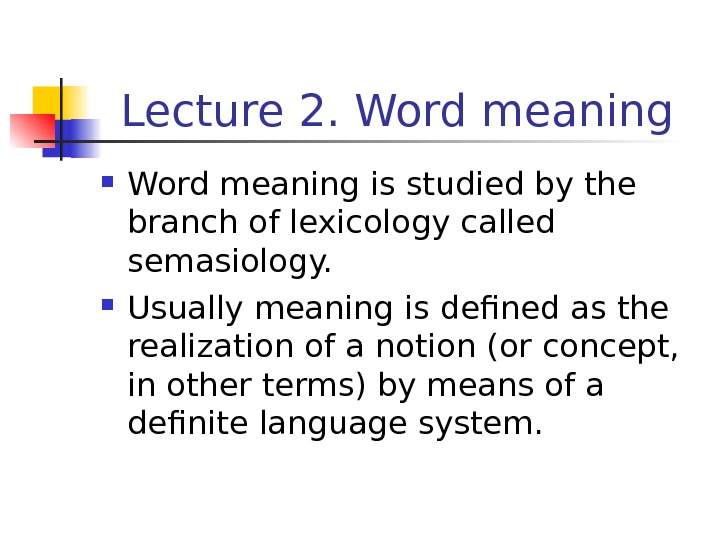
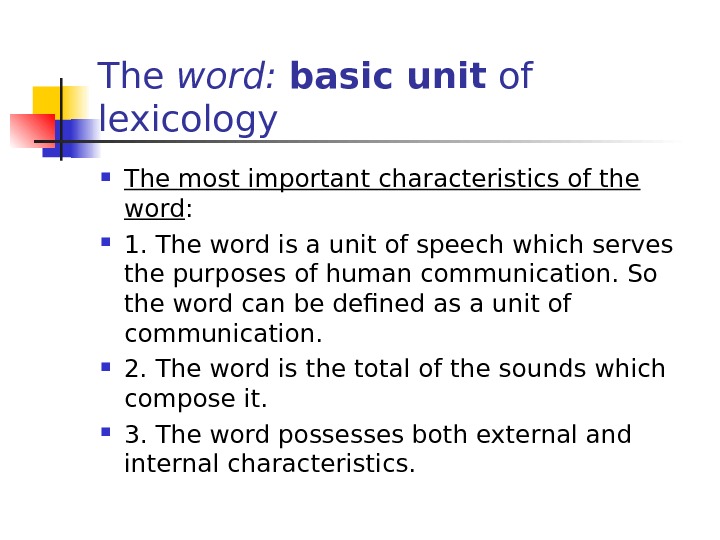
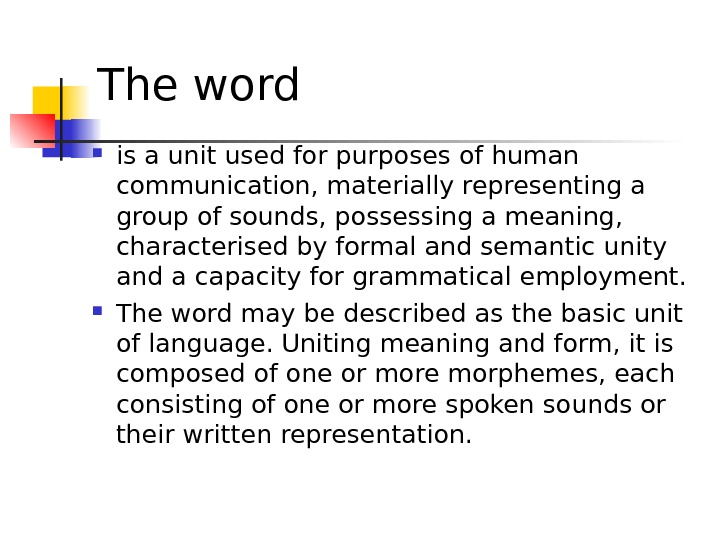
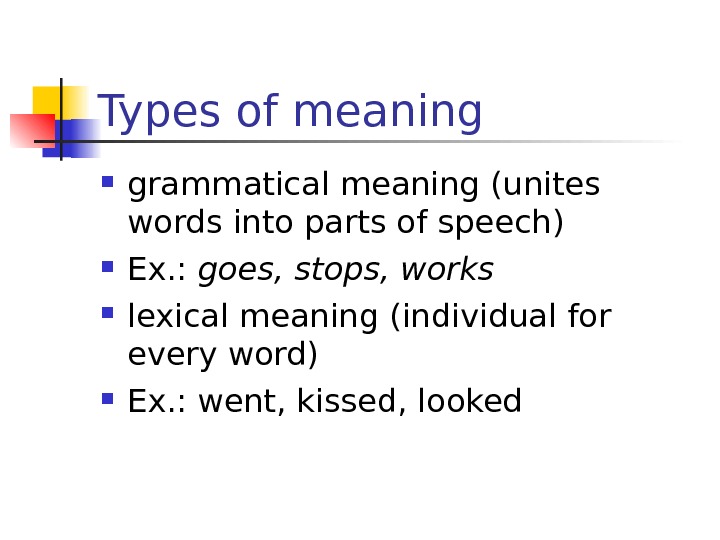
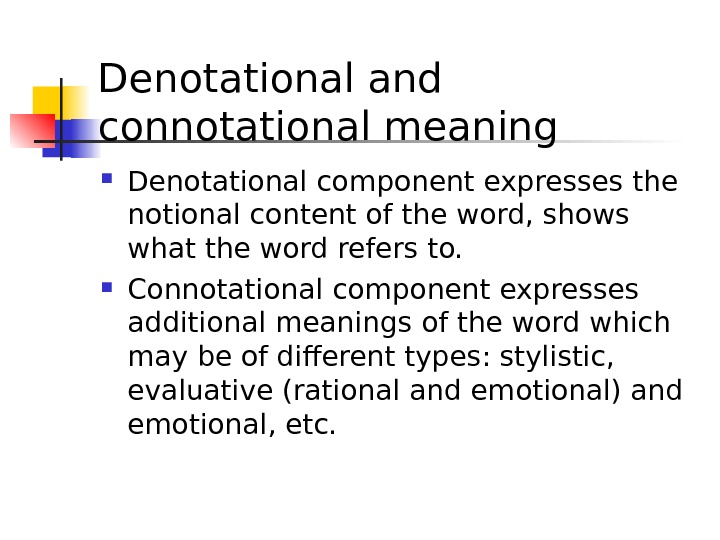


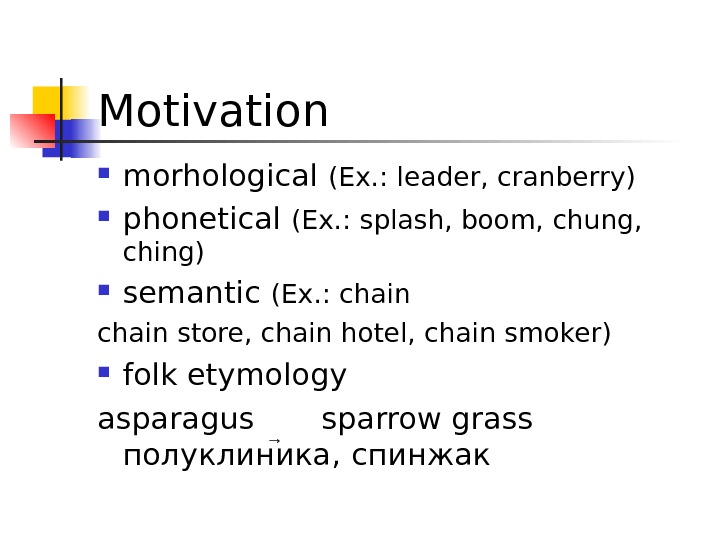

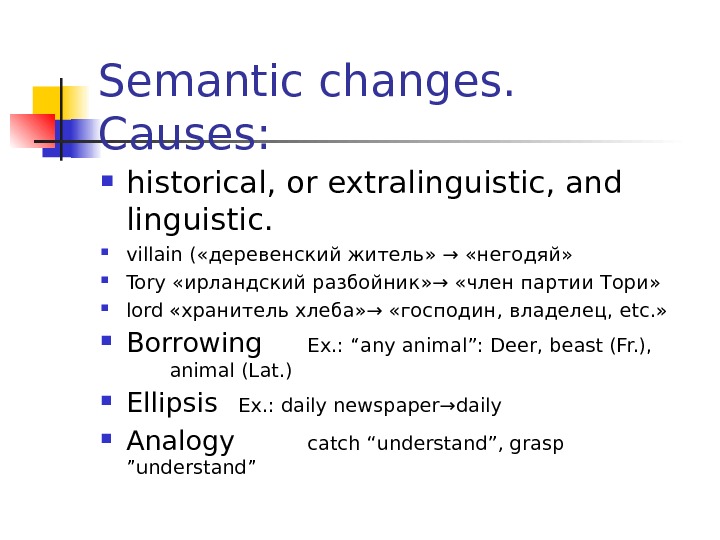
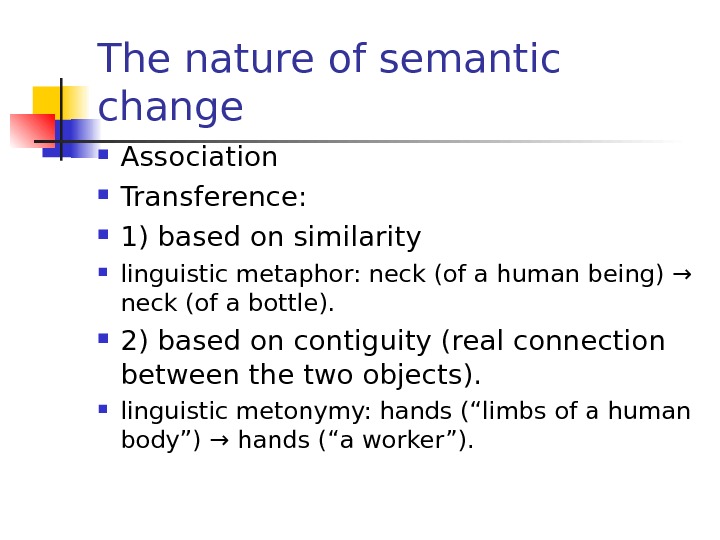
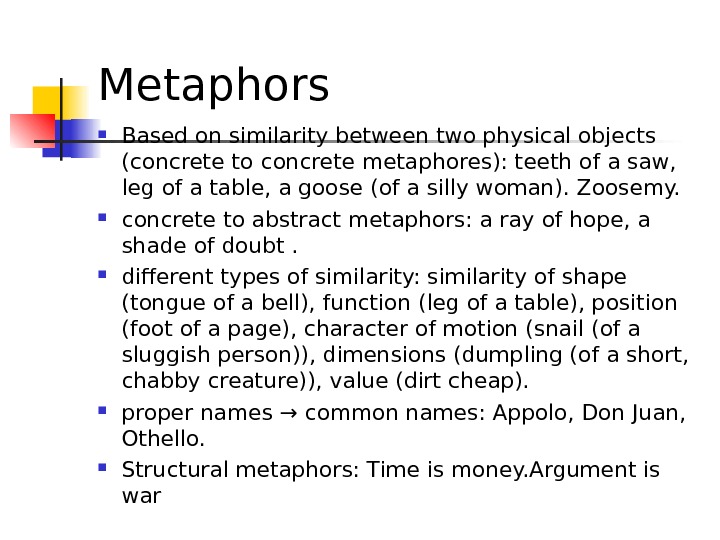



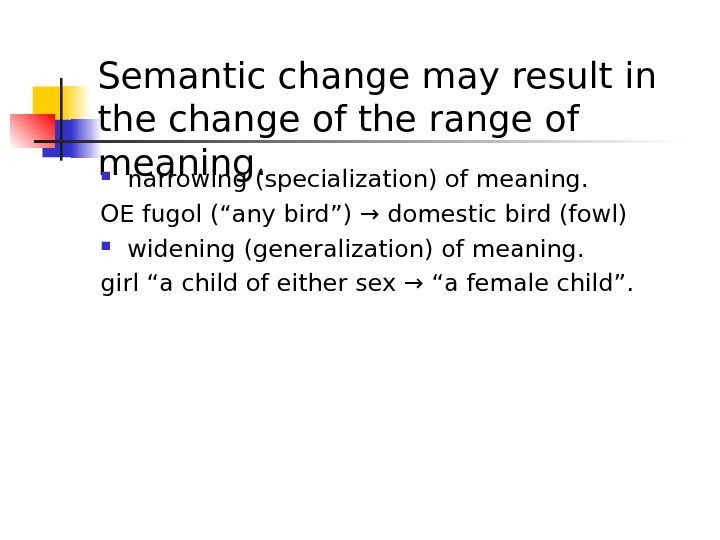
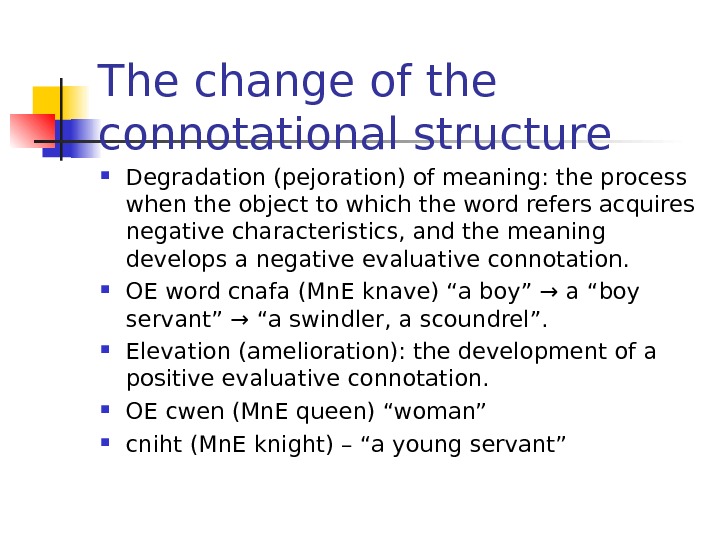
Parts of Speech. Principles of Classification of the Parts of Speech.
√ Parts of speech.
√ Semantic.
√ Morphological.
√ Syntactic.
√ Meaning.
√ Form.
√ Function
√ Meaning
Parts of speech
Parts of speech are grammatical classes of words which are distinguished on the basis of four criteria:
— semantic;
— morphological;
— syntactic;
that of valency (combinability)
1) Meaning. Each part of speech is characterized by the general meaning which is an abstraction from the lexical meaning of the constituent word. Thus, the general meaning of nouns is thingness (substance), the general meaning of verbs is action, state, process; the general meaning of adjectives — quality, quantity.
The general meaning is understood as categorial meaning of the class of words.
Semantic properties of every part of speech find their expression in their grammatical properties. If we take «to sleep, a night sleep, sleepy, asleep» they all refer to the same phenomena of the objective reality but belong to different parts of speech as they have different grammatical properties.
Meaning is supportive criterion in the English language which only helps to check purely grammatical criteria — those of form and function.
Глокая куздра штэка будланула бокра и кудрячит бокрёнка. V. V. Vinogradov
Green ideas sleep furiously.
Such examples though being artificial help us to understand that — grammatical meaning is an objective thing by itself though in real speech it never exists without lexical meaning.
2) Form, (morphological properties) The formal criterion concerns the inflectional and derivational features of words belonging to a given class. That is the grammatical categories they possess, the paradigms they form and derivational and functional morphemes they have.
With the English language this criterion is not always reliable as many words in English are invariable, many words have no derivational affixes and besides the same derivational affixes may be used to build different parts of speech.(e.g. «~ly»: quickly , daily , weakly(n.)).
Because of the limitation of meaning and form as criterion we should rely mainly on words’ syntactic functions (e.g. «round» can be adjective, noun, verb, preposition).
3) Function. Syntactic properties of any class of words are: combinability (distributional criterion), typical syntactic functions in a sentence. The three criteria of defining grammatical classes of words in English may be placed in the following order: syntactic, distribution, form, meaning (Russian: form, meaning, syntactic distribution).
Parts of speech are heterogeneous classes and the boundaries between them are not clearly cut especially in the area of meaning. Within a part of speech there are subclasses which have all the properties of a given class and subclasses which have only some of these properties and may even have features of another class.
So a part of speech may be described as a field which includes both central (most typical) members and marginal (less typical) members. Marginal areas of different parts of speech may overlap and there may be intermediary elements with contradicting features (modal words, statives, pronouns and even verbs).
Words belonging to different parts of speech may be united by common feature and they may constitute a class cutting across other classes (e.g. determiners or quantifiers).
Possible Ways of the Grammatical Classification of the Vocabulary.
The parts of speech and their classification usually involves all the four criteria mentioned and scholars single out from 8 to 13 parts of speech in modern English. The founder of English scientific grammar Henry Sweet finds the following classes of words: noun-words ( here he includes some pronouns and numerals), adjective-words, verbs 4 particles (by this term he denotes words of different classes which have no grammatical categories).
The opposite criterion — structural or distributional — was used by an American scholar Charles Freeze. Each class of words is characterized by a set of positions in a sentence which are defined by substitution test. As a result of distributional analysis Freeze singles out 4 main classes of words roughly corresponding to verbs, nouns, adjectives, adverbs and 15 classes of function-words.
Notional and Functional Parts of Speech.
Both the traditional and distributional classification divide parts of speech into notional and functional. Notional parts of speech are open classes, new items can be added to them, we extend them indefinitely. Functional parts of speech are closed systems including a limited number of members. As a rule they cannot be extended by creating new items.
Main notional parts of speech are nouns, verbs, adjectives, adverbs. Members of these four classes are often connected derivationally. Functional parts of speech are prepositions, conjunctions, articles, interjections & particles. Their distinctive features are:
— very general & weak lexical meaning;
— obligatory combinability;
The function of linking and specifying words.
Pronouns constitute a class of words which takes an intermediary position between notional and functional words: on the one hand they can substitute nouns and adjectives; on the other hand they can be used as connectives and specifiers. There may be also groups of closed-system items within an open class (notional, functional and auxiliary verbs).
A word in English is very often not marked morphologically. It makes it easy for words to pass from one class to another. Such words are treated as either lexico-semantic phonemes or as words belonging to one class. The problem which is closely connected with the selection of parts of speech is the problem of conversion.
There are usually the cases of absolute, phonetic identity of words belonging to different parts of speech. About 45% of nouns can be converted into verbs and about 50% of verbs — into nouns. There are different viewpoints on conversion: some scholars think that it is a syntactic word-building means. If they say so they do admit that the word may function as parts of speech at the same time.
Russian linguist Galperin defines conversion as a non-affix way of forming words. There is another theory by French linguist Morshaw who states that conversion is a creation of new words with zero-affix. In linguistics this problem is called «stone-wall-construction problem».
Another factor which makes difficult to select parts of speech, in English is abundance of homonyms in English. They are words and forms identical in form, sounding, spelling, but different in meaning. Usually the great number of homonyms in English is explained by monosyllabic structure of words but it’s not all the explanation.
The words are monosyllabic in English because there are few endings in it, because English is predominantly analytical. We differentiate between full and partial homonymity, we usually observe full homonymity within one pan of speech and partial — within different parts of speech. If we have two homonyms within one part of speech their paradigms should fully coincide.
Homonyms can be classified into lexical, lexico-grammatical and purely grammatical. We should differentiate between homonymity and polysemantic words.
The terms «part of speech», «word class» and «word category» are typically used interchangeably. For a recent, brief and accessible discussion by an eminent linguist, see this paper by David Denison. Each individual word has its own part of speech.
Subject and object are grammatical relations. Grammatical relations are different from parts of speech, because parts of speech do not depend on the role of the word in the sentence, whereas grammatical relations do. For instance, in the sentence Cats like mice, the words cats and mice are both nouns, but Cats is the subject whereas mice is the direct object. In the sentence Mice like cats, it is the other way round: mice is the subject whereas cats is the direct object.
An important difference between parts of speech and grammatical relations is that phrases can bear grammatical relations, but only words can bear parts of speech. In the sentence The cats like the mice, the subject is the whole phrase The cats. The word cats is a noun, and The is an article or a determiner.
If you want to find out more about these notions, I’d recommend the book Introducing English Grammar by Börjars and Burridge (2010). It’s what we use at Manchester to teach first-year Linguistics and English Language undergraduates.
In grammar, a part of speech or part-of-speech (abbreviated as POS or PoS, also known as word class[1] or grammatical category[2]) is a category of words (or, more generally, of lexical items) that have similar grammatical properties. Words that are assigned to the same part of speech generally display similar syntactic behavior (they play similar roles within the grammatical structure of sentences), sometimes similar morphological behavior in that they undergo inflection for similar properties and even similar semantic behavior. Commonly listed English parts of speech are noun, verb, adjective, adverb, pronoun, preposition, conjunction, interjection, numeral, article, and determiner.
Other terms than part of speech—particularly in modern linguistic classifications, which often make more precise distinctions than the traditional scheme does—include word class, lexical class, and lexical category. Some authors restrict the term lexical category to refer only to a particular type of syntactic category; for them the term excludes those parts of speech that are considered to be function words, such as pronouns. The term form class is also used, although this has various conflicting definitions.[3] Word classes may be classified as open or closed: open classes (typically including nouns, verbs and adjectives) acquire new members constantly, while closed classes (such as pronouns and conjunctions) acquire new members infrequently, if at all.
Almost all languages have the word classes noun and verb, but beyond these two there are significant variations among different languages.[4] For example:
- Japanese has as many as three classes of adjectives, where English has one.
- Chinese, Korean, Japanese and Vietnamese have a class of nominal classifiers.
- Many languages do not distinguish between adjectives and adverbs, or between adjectives and verbs (see stative verb).
Because of such variation in the number of categories and their identifying properties, analysis of parts of speech must be done for each individual language. Nevertheless, the labels for each category are assigned on the basis of universal criteria.[4]
History[edit]
The classification of words into lexical categories is found from the earliest moments in the history of linguistics.[5]
India[edit]
In the Nirukta, written in the 6th or 5th century BCE, the Sanskrit grammarian Yāska defined four main categories of words:[6]
- नाम nāma – noun (including adjective)
- आख्यात ākhyāta – verb
- उपसर्ग upasarga – pre-verb or prefix
- निपात nipāta – particle, invariant word (perhaps preposition)
These four were grouped into two larger classes: inflectable (nouns and verbs) and uninflectable (pre-verbs and particles).
The ancient work on the grammar of the Tamil language, Tolkāppiyam, argued to have been written around 2nd century CE,[7] classifies Tamil words as peyar (பெயர்; noun), vinai (வினை; verb), idai (part of speech which modifies the relationships between verbs and nouns), and uri (word that further qualifies a noun or verb).[8]
Western tradition[edit]
A century or two after the work of Yāska, the Greek scholar Plato wrote in his Cratylus dialogue, «sentences are, I conceive, a combination of verbs [rhêma] and nouns [ónoma]».[9] Aristotle added another class, «conjunction» [sýndesmos], which included not only the words known today as conjunctions, but also other parts (the interpretations differ; in one interpretation it is pronouns, prepositions, and the article).[10]
By the end of the 2nd century BCE, grammarians had expanded this classification scheme into eight categories, seen in the Art of Grammar, attributed to Dionysius Thrax:[11]
- ‘Name’ (ónoma) translated as «Noun«: a part of speech inflected for case, signifying a concrete or abstract entity. It includes various species like nouns, adjectives, proper nouns, appellatives, collectives, ordinals, numerals and more.[12]
- Verb (rhêma): a part of speech without case inflection, but inflected for tense, person and number, signifying an activity or process performed or undergone
- Participle (metokhḗ): a part of speech sharing features of the verb and the noun
- Article (árthron): a declinable part of speech, taken to include the definite article, but also the basic relative pronoun
- Pronoun (antōnymíā): a part of speech substitutable for a noun and marked for a person
- Preposition (próthesis): a part of speech placed before other words in composition and in syntax
- Adverb (epírrhēma): a part of speech without inflection, in modification of or in addition to a verb, adjective, clause, sentence, or other adverb
- Conjunction (sýndesmos): a part of speech binding together the discourse and filling gaps in its interpretation
It can be seen that these parts of speech are defined by morphological, syntactic and semantic criteria.
The Latin grammarian Priscian (fl. 500 CE) modified the above eightfold system, excluding «article» (since the Latin language, unlike Greek, does not have articles) but adding «interjection».[13][14]
The Latin names for the parts of speech, from which the corresponding modern English terms derive, were nomen, verbum, participium, pronomen, praepositio, adverbium, conjunctio and interjectio. The category nomen included substantives (nomen substantivum, corresponding to what are today called nouns in English), adjectives (nomen adjectivum) and numerals (nomen numerale). This is reflected in the older English terminology noun substantive, noun adjective and noun numeral. Later[15] the adjective became a separate class, as often did the numerals, and the English word noun came to be applied to substantives only.
Classification[edit]
Works of English grammar generally follow the pattern of the European tradition as described above, except that participles are now usually regarded as forms of verbs rather than as a separate part of speech, and numerals are often conflated with other parts of speech: nouns (cardinal numerals, e.g., «one», and collective numerals, e.g., «dozen»), adjectives (ordinal numerals, e.g., «first», and multiplier numerals, e.g., «single») and adverbs (multiplicative numerals, e.g., «once», and distributive numerals, e.g., «singly»). Eight or nine parts of speech are commonly listed:
- noun
- verb
- adjective
- adverb
- pronoun
- preposition
- conjunction
- interjection
- article* or (more recently) determiner
Additionally, there are other parts of speech including particles (yes, no)[a] and postpositions (ago, notwithstanding) although many fewer words are in these categories.
Some traditional classifications consider articles to be adjectives, yielding eight parts of speech rather than nine. And some modern classifications define further classes in addition to these. For discussion see the sections below.
The classification below, or slight expansions of it, is still followed in most dictionaries:
- Noun (names)
- a word or lexical item denoting any abstract (abstract noun: e.g. home) or concrete entity (concrete noun: e.g. house); a person (police officer, Michael), place (coastline, London), thing (necktie, television), idea (happiness), or quality (bravery). Nouns can also be classified as count nouns or non-count nouns; some can belong to either category. The most common part of speech; they are called naming words.
- Pronoun (replaces or places again)
- a substitute for a noun or noun phrase (them, he). Pronouns make sentences shorter and clearer since they replace nouns.
- Adjective (describes, limits)
- a modifier of a noun or pronoun (big, brave). Adjectives make the meaning of another word (noun) more precise.
- Verb (states action or being)
- a word denoting an action (walk), occurrence (happen), or state of being (be). Without a verb, a group of words cannot be a clause or sentence.
- Adverb (describes, limits)
- a modifier of an adjective, verb, or another adverb (very, quite). Adverbs make language more precise.
- Preposition (relates)
- a word that relates words to each other in a phrase or sentence and aids in syntactic context (in, of). Prepositions show the relationship between a noun or a pronoun with another word in the sentence.
- Conjunction (connects)
- a syntactic connector; links words, phrases, or clauses (and, but). Conjunctions connect words or group of words
- Interjection (expresses feelings and emotions)
- an emotional greeting or exclamation (Huzzah, Alas). Interjections express strong feelings and emotions.
- Article (describes, limits)
- a grammatical marker of definiteness (the) or indefiniteness (a, an). The article is not always listed among the parts of speech. It is considered by some grammarians to be a type of adjective[16] or sometimes the term ‘determiner’ (a broader class) is used.
English words are not generally marked as belonging to one part of speech or another; this contrasts with many other European languages, which use inflection more extensively, meaning that a given word form can often be identified as belonging to a particular part of speech and having certain additional grammatical properties. In English, most words are uninflected, while the inflected endings that exist are mostly ambiguous: -ed may mark a verbal past tense, a participle or a fully adjectival form; -s may mark a plural noun, a possessive noun, or a present-tense verb form; -ing may mark a participle, gerund, or pure adjective or noun. Although -ly is a frequent adverb marker, some adverbs (e.g. tomorrow, fast, very) do not have that ending, while many adjectives do have it (e.g. friendly, ugly, lovely), as do occasional words in other parts of speech (e.g. jelly, fly, rely).
Many English words can belong to more than one part of speech. Words like neigh, break, outlaw, laser, microwave, and telephone might all be either verbs or nouns. In certain circumstances, even words with primarily grammatical functions can be used as verbs or nouns, as in, «We must look to the hows and not just the whys.» The process whereby a word comes to be used as a different part of speech is called conversion or zero derivation.
Functional classification[edit]
Linguists recognize that the above list of eight or nine word classes is drastically simplified.[17] For example, «adverb» is to some extent a catch-all class that includes words with many different functions. Some have even argued that the most basic of category distinctions, that of nouns and verbs, is unfounded,[18] or not applicable to certain languages.[19][20] Modern linguists have proposed many different schemes whereby the words of English or other languages are placed into more specific categories and subcategories based on a more precise understanding of their grammatical functions.
Common lexical category set defined by function may include the following (not all of them will necessarily be applicable in a given language):
- Categories that will usually be open classes:
- adjectives
- adverbs
- nouns
- verbs (except auxiliary verbs)
- interjections
- Categories that will usually be closed classes:
- auxiliary verbs
- clitics
- coverbs
- conjunctions
- determiners (articles, quantifiers, demonstrative adjectives, and possessive adjectives)
- particles
- measure words or classifiers
- adpositions (prepositions, postpositions, and circumpositions)
- preverbs
- pronouns
- contractions
- cardinal numbers
Within a given category, subgroups of words may be identified based on more precise grammatical properties. For example, verbs may be specified according to the number and type of objects or other complements which they take. This is called subcategorization.
Many modern descriptions of grammar include not only lexical categories or word classes, but also phrasal categories, used to classify phrases, in the sense of groups of words that form units having specific grammatical functions. Phrasal categories may include noun phrases (NP), verb phrases (VP) and so on. Lexical and phrasal categories together are called syntactic categories.
Open and closed classes[edit]
Word classes may be either open or closed. An open class is one that commonly accepts the addition of new words, while a closed class is one to which new items are very rarely added. Open classes normally contain large numbers of words, while closed classes are much smaller. Typical open classes found in English and many other languages are nouns, verbs (excluding auxiliary verbs, if these are regarded as a separate class), adjectives, adverbs and interjections. Ideophones are often an open class, though less familiar to English speakers,[21][22][b] and are often open to nonce words. Typical closed classes are prepositions (or postpositions), determiners, conjunctions, and pronouns.[24]
The open–closed distinction is related to the distinction between lexical and functional categories, and to that between content words and function words, and some authors consider these identical, but the connection is not strict. Open classes are generally lexical categories in the stricter sense, containing words with greater semantic content,[25] while closed classes are normally functional categories, consisting of words that perform essentially grammatical functions. This is not universal: in many languages verbs and adjectives[26][27][28] are closed classes, usually consisting of few members, and in Japanese the formation of new pronouns from existing nouns is relatively common, though to what extent these form a distinct word class is debated.
Words are added to open classes through such processes as compounding, derivation, coining, and borrowing. When a new word is added through some such process, it can subsequently be used grammatically in sentences in the same ways as other words in its class.[29] A closed class may obtain new items through these same processes, but such changes are much rarer and take much more time. A closed class is normally seen as part of the core language and is not expected to change. In English, for example, new nouns, verbs, etc. are being added to the language constantly (including by the common process of verbing and other types of conversion, where an existing word comes to be used in a different part of speech). However, it is very unusual for a new pronoun, for example, to become accepted in the language, even in cases where there may be felt to be a need for one, as in the case of gender-neutral pronouns.
The open or closed status of word classes varies between languages, even assuming that corresponding word classes exist. Most conspicuously, in many languages verbs and adjectives form closed classes of content words. An extreme example is found in Jingulu, which has only three verbs, while even the modern Indo-European Persian has no more than a few hundred simple verbs, a great deal of which are archaic. (Some twenty Persian verbs are used as light verbs to form compounds; this lack of lexical verbs is shared with other Iranian languages.) Japanese is similar, having few lexical verbs.[30] Basque verbs are also a closed class, with the vast majority of verbal senses instead expressed periphrastically.
In Japanese, verbs and adjectives are closed classes,[31] though these are quite large, with about 700 adjectives,[32][33] and verbs have opened slightly in recent years. Japanese adjectives are closely related to verbs (they can predicate a sentence, for instance). New verbal meanings are nearly always expressed periphrastically by appending suru (する, to do) to a noun, as in undō suru (運動する, to (do) exercise), and new adjectival meanings are nearly always expressed by adjectival nouns, using the suffix -na (〜な) when an adjectival noun modifies a noun phrase, as in hen-na ojisan (変なおじさん, strange man). The closedness of verbs has weakened in recent years, and in a few cases new verbs are created by appending -ru (〜る) to a noun or using it to replace the end of a word. This is mostly in casual speech for borrowed words, with the most well-established example being sabo-ru (サボる, cut class; play hooky), from sabotāju (サボタージュ, sabotage).[34] This recent innovation aside, the huge contribution of Sino-Japanese vocabulary was almost entirely borrowed as nouns (often verbal nouns or adjectival nouns). Other languages where adjectives are closed class include Swahili,[28] Bemba, and Luganda.
By contrast, Japanese pronouns are an open class and nouns become used as pronouns with some frequency; a recent example is jibun (自分, self), now used by some young men as a first-person pronoun. The status of Japanese pronouns as a distinct class is disputed,[by whom?] however, with some considering it only a use of nouns, not a distinct class. The case is similar in languages of Southeast Asia, including Thai and Lao, in which, like Japanese, pronouns and terms of address vary significantly based on relative social standing and respect.[35]
Some word classes are universally closed, however, including demonstratives and interrogative words.[35]
See also[edit]
- Part-of-speech tagging
- Sliding window based part-of-speech tagging
Notes[edit]
- ^ Yes and no are sometimes classified as interjections.
- ^ Ideophones do not always form a single grammatical word class, and their classification varies between languages, sometimes being split across other word classes. Rather, they are a phonosemantic word class, based on derivation, but may be considered part of the category of «expressives»,[21] which thus often form an open class due to the productivity of ideophones. Further, «[i]n the vast majority of cases, however, ideophones perform an adverbial function and are closely linked with verbs.»[23]
References[edit]
- ^ Rijkhoff, Jan (2007). «Word Classes». Language and Linguistics Compass. Wiley. 1 (6): 709–726. doi:10.1111/j.1749-818x.2007.00030.x. ISSN 1749-818X. S2CID 5404720.
- ^ Payne, Thomas E. (1997). Describing morphosyntax: a guide for field linguists. Cambridge. ISBN 9780511805066.
- ^ John Lyons, Semantics, CUP 1977, p. 424.
- ^ a b Kroeger, Paul (2005). Analyzing Grammar: An Introduction. Cambridge: Cambridge University Press. p. 35. ISBN 978-0-521-01653-7.
- ^ Robins RH (1989). General Linguistics (4th ed.). London: Longman.
- ^
Bimal Krishna Matilal (1990). The word and the world: India’s contribution to the study of language (Chapter 3). - ^ Mahadevan, I. (2014). Early Tamil Epigraphy — From the Earliest Times to the Sixth century C.E., 2nd Edition. p. 271.
- ^
Ilakkuvanar S (1994). Tholkappiyam in English with critical studies (2nd ed.). Educational Publisher. - ^ Cratylus 431b
- ^ The Rhetoric, Poetic and Nicomachean Ethics of Aristotle, translated by Thomas Taylor, London 1811, p. 179.
- ^ Dionysius Thrax. τέχνη γραμματική (Art of Grammar), ια´ περὶ λέξεως (11. On the word):
- λέξις ἐστὶ μέρος ἐλάχιστον τοῦ κατὰ σύνταξιν λόγου.
λόγος δέ ἐστι πεζῆς λέξεως σύνθεσις διάνοιαν αὐτοτελῆ δηλοῦσα.
τοῦ δὲ λόγου μέρη ἐστὶν ὀκτώ· ὄνομα, ῥῆμα,
μετοχή, ἄρθρον, ἀντωνυμία, πρόθεσις, ἐπίρρημα, σύνδεσμος. ἡ γὰρ προσηγορία ὡς εἶδος τῶι ὀνόματι ὑποβέβληται. - A word is the smallest part of organized speech.
Speech is the putting together of an ordinary word to express a complete thought.
The class of word consists of eight categories: noun, verb,
participle, article, pronoun, preposition, adverb, conjunction. A common noun in form is classified as a noun.
- λέξις ἐστὶ μέρος ἐλάχιστον τοῦ κατὰ σύνταξιν λόγου.
- ^ The term ‘onoma’ at Dionysius Thrax, Τέχνη γραμματική (Art of Grammar), 14. Περὶ ὀνόματος translated by Thomas Davidson, On the noun
- καὶ αὐτὰ εἴδη προσαγορεύεται· κύριον, προσηγορικόν, ἐπίθετον, πρός τι ἔχον, ὡς πρός τι ἔχον, ὁμώνυμον, συνώνυμον, διώνυμον, ἐπώνυμον, ἐθνικόν, ἐρωτηματικόν, ἀόριστον, ἀναφορικὸν ὃ καὶ ὁμοιωματικὸν καὶ δεικτικὸν καὶ ἀνταποδοτικὸν καλεῖται, περιληπτικόν, ἐπιμεριζόμενον, περιεκτικόν, πεποιημένον, γενικόν, ἰδικόν, τακτικόν, ἀριθμητικόν, ἀπολελυμένον, μετουσιαστικόν.
- also called Species: proper, appellative, adjective, relative, quasi-relative, homonym, synonym, pheronym, dionym, eponym, national, interrogative, indefinite, anaphoric (also called assimilative, demonstrative, and retributive), collective, distributive, inclusive, onomatopoetic, general, special, ordinal, numeral, participative, independent.
- ^ [penelope.uchicago.edu/Thayer/E/Roman/Texts/Quintilian/Institutio_Oratoria/1B*.html This translation of Quintilian’s Institutio Oratoria reads: «Our own language (Note: i.e. Latin) dispenses with the articles (Note: Latin doesn’t have articles), which are therefore distributed among the other parts of speech. But interjections must be added to those already mentioned.»]
- ^ «Quintilian: Institutio Oratoria I».
- ^ See for example Beauzée, Nicolas, Grammaire générale, ou exposition raisonnée des éléments nécessaires du langage (Paris, 1767), and earlier Jakob Redinger, Comeniana Grammatica Primae Classi Franckenthalensis Latinae Scholae destinata … (1659, in German and Latin).
- ^ The Oxford Dictionary of English Grammar by Bas Aarts, Sylvia Chalker & Edmund Weine. OUP Oxford 2014. Page 35.
- ^ Zwicky, Arnold (30 March 2006). «What part of speech is «the»«. Language Log. Retrieved 26 December 2009.
…the school tradition about parts of speech is so desperately impoverished
- ^ Hopper, P; Thompson, S (1985). «The Iconicity of the Universal Categories ‘Noun’ and ‘Verbs’«. In John Haiman (ed.). Typological Studies in Language: Iconicity and Syntax. Vol. 6. Amsterdam: John Benjamins Publishing Company. pp. 151–183.
- ^ Launey, Michel (1994). Une grammaire omniprédicative: essai sur la morphosyntaxe du nahuatl classique. Paris: CNRS Editions.
- ^ Broschart, Jürgen (1997). «Why Tongan does it differently: Categorial Distinctions in a Language without Nouns and Verbs». Linguistic Typology. 1 (2): 123–165. doi:10.1515/lity.1997.1.2.123. S2CID 121039930.
- ^ a b The Art of Grammar: A Practical Guide, Alexandra Y. Aikhenvald, p. 99
- ^ G. Tucker Childs, «African ideophones», in Sound Symbolism, p. 179
- ^ G. Tucker Childs, «African ideophones», in Sound Symbolism, p. 181
- ^ «Sample Entry: Function Words / Encyclopedia of Linguistics».
- ^ Carnie, Andrew (2012). Syntax: A Generative Introduction. New Jersey: Wiley-Blackwell. pp. 51–52. ISBN 978-0-470-65531-3.
- ^ Dixon, Robert M. W. (1977). «Where Have all the Adjectives Gone?». Studies in Language. 1: 19–80. doi:10.1075/sl.1.1.04dix.
- ^ Adjective classes: a cross-linguistic typology, Robert M. W. Dixon, Alexandra Y. Aikhenvald, OUP Oxford, 2006
- ^ a b The Art of Grammar: A Practical Guide, Alexandra Y. Aikhenvald, p. 97
- ^ Hoff, Erika (2014). Language Development. Belmont, CA: Cengage Learning. p. 171. ISBN 978-1-133-93909-2.
- ^ Categorial Features: A Generative Theory of Word Class Categories, «p. 54».
- ^ Dixon 1977, p. 48.
- ^ The Typology of Adjectival Predication, Harrie Wetzer, p. 311
- ^ The Art of Grammar: A Practical Guide, Alexandra Y. Aikhenvald, p. 96
- ^ Adam (2011-07-18). «Homage to る(ru), The Magical Verbifier».
- ^ a b The Art of Grammar: A Practical Guide, Alexandra Y. Aikhenvald, p. 98
External links[edit]
Media related to Parts of speech at Wikimedia Commons
- The parts of speech
- Guide to Grammar and Writing
- Martin Haspelmath. 2001. «Word Classes and Parts of Speech.» In: Baltes, Paul B. & Smelser, Neil J. (eds.) International Encyclopedia of the Social and Behavioral Sciences. Amsterdam: Pergamon, 16538–16545. (PDF)



